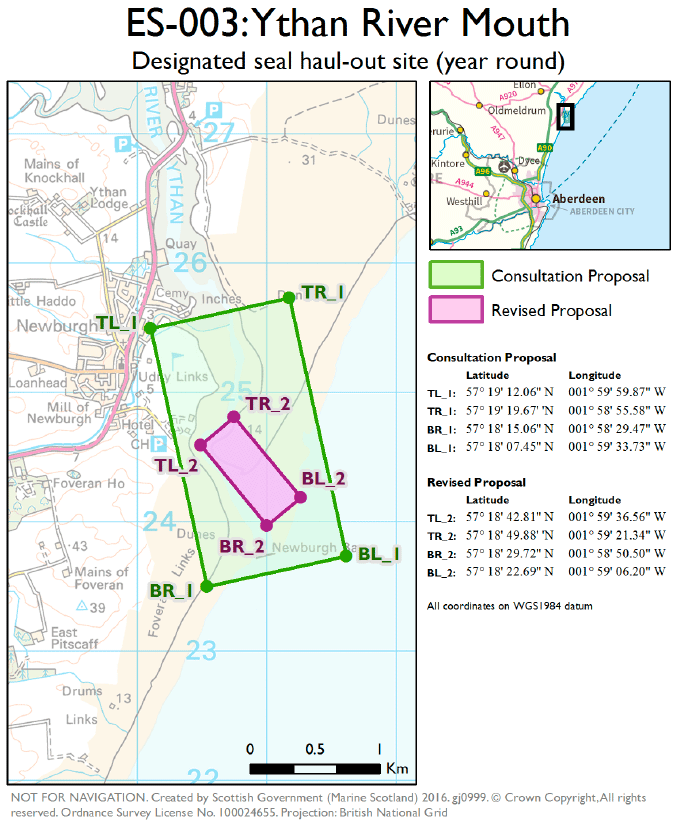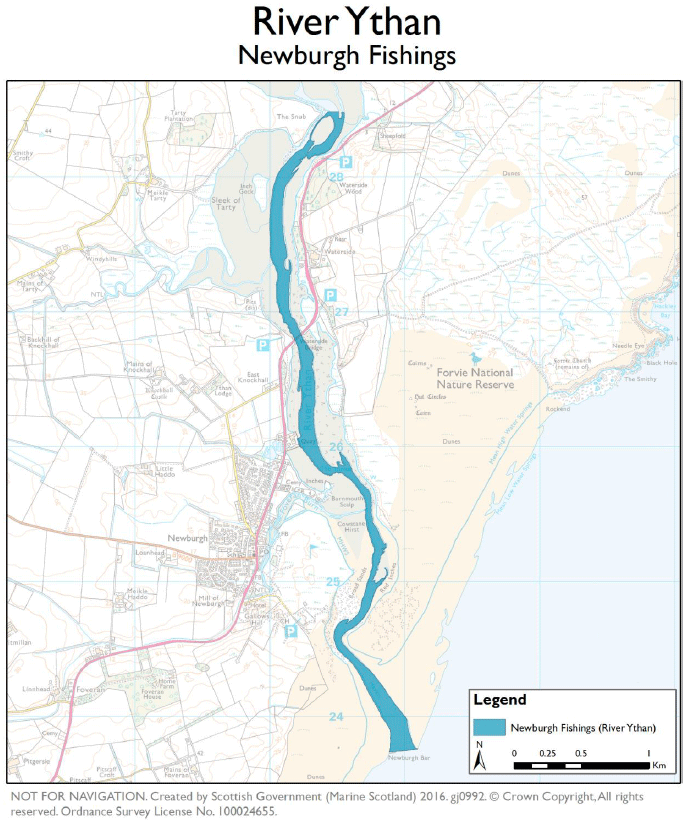Designation of a seal haul-out site in the Ythan Estuary: analysis of consultation responses
Analysis of responses to the consultation on the proposal to designate a seal haul-out site.
3. Key Themes
3.1. Public Access
A close analysis of yes and no responses indicated an important issue that influenced responses to the consultation. This was a fear that designation might restrict or deny public access to the entire proposed area and a resultant desire that the designated area be more closely defined to the area where seals haul-out. Some argued that the co-ordinates do not represent where the seals haul-out and intrude on large areas of public access and amenity.
84 respondents based their no answer on fear of denial of public access. A further 70 respondents who answered no to designation and 15 of those who answered yes specified they would only support designation of the northern [5] side of the estuary mouth where seals normally haul-out. This makes a total of 169 respondents whose concerns were around public access to the southern shore.
Examples included:
The area proposed is very much larger than the actual haul-out site and includes much of the South bank which is popular with dog walkers, horse riders, nature watchers and, to a much lesser extent, anglers. This also includes part of the Golf Course. It seems inappropriate to consider designation of areas where seals do not currently haul-out .
The south bank of the river is used by residents and visitors for walking, bird watching and recreation. There is also an 18 hole championship golf course part of which appears to be within the site. This is an important asset to the local economy. We have lived in the area for 16 years and have enjoyed these facilities with our children and now hope to continue to do so in our retirement.
The proposal neither explains nor proves beyond any doubt that access to the proposed area will in any way be restricted to walkers, dog walkers, golfers and fishermen. We cannot risk the loss of such an important facility to the Newburgh community by creating this vast area, then along comes a body with extremist views who could seek legally, to ban access to the site.
Two responses submitted maps suggesting a much smaller area should be designated, where seals can normally be found.
A number (n=7) of comments stressed that disturbance by the public on the north shore is not an issue and that wildlife enthusiasts can watch and admire the seals from the south side of the Ythan.
Some said that inclusion of south and west shores would further antagonise people against the seals.
Scottish Government response:
It was never intended that the designated area itself would involve any denial of public access but only that public access be restricted when it might result in harassment of the seals. The size of the area was selected in order to ensure protection for the locations where seals haul-out. Any existing activities, which have not caused any disturbance to seals in the past, can continue within the site boundaries as long as they avoid harassment [6] of hauled-out seals.
In light of the comments and issues raised, however, the original boundaries of the proposed site were reviewed in consultation with SMRU and SNH. This produced a smaller site more closely aligned to where the seals haul-out. This new site should resolve the majority of public access concerns since it confines the designated area to the north bank as requested by many respondents. It also resolves the majority of public access issues, which almost entirely related to south and west shores, by excluding these from the new site (Figure 4).

Figure 4. Comparison between the original consultation proposal (green rectangle) and the revised proposal (pink rectangle)
3.2. Fisheries
Concerns about the potential impact on local fishing were raised by 49 respondents, all from the fishing interests in the area. Seven fishery groups responded to the consultation, and 42 individuals responded, who practice recreational fishing in the area.
Twenty-seven out of 49 responses expressed concerns about declining salmon and sea trout in the estuary and asserted that the presence of large numbers of seals would impact on migratory fish. Sea trout are present in the estuary all year round and the Ythan is regarded as an important feeding ground for these species and the risk of predation by seals is much higher than that of salmon.
Twenty respondents voiced concerns that the proposed area would stop anglers from carrying out fishing in the Lower River or Estuary. Some even mentioned that the increase in seal numbers has already led to anglers no longer fishing in the lower part of the estuary. Many feared the designation would further restrict their activity which could lead to losses to the local economy, loss of salmon runs, and reduced catches of other fish species such as sea bass and flat fish.
Two netting interest strongly objected to the proposal. Their opinion was that the designation would materially impact their operations in a negative manner and that they will no longer be able to carry out their activity.
Examples included:
From personal observations over the past 25 years it is obvious the grey seal population at the Ythan estuary is growing exponentially without any assistance whatsoever. Further, the Atlantic salmon and sea-trout populations are crashing for numerous reasons , amongst which may possibly include seal predation.
In the wider scheme of things the Scottish Government ought to give due weight, not only to the welfare of seals, but also to the inversely associated welfare of migratory salmon and sea trout. The importance of these to the economy of the East of Scotland should not be underestimated - was clearly highlighted during the recent Scottish Wild Fisheries Review. I note that the Ythan is listed in Category 2, where "Management action is necessary to reduce exploitation (…).
It seems perverse to restrict killing of wild salmon by fishermen whilst encouraging and enhancing such killing by seals! Sea trout have been on the UK Biodiversity Action Plan Priority Species list since 2007.
I enjoy watching seals very much and marvel at their skills in the water but I regard their numbers at Newburgh are almost at vermin levels (…)It is unsustainable in a very special area such as this. A cull should be undertaken for the health of the river and the estuary and indeed for the seals themselves.
Scottish Government response
Seal Numbers on the Haul-out
A number of fishery responses were concerned that the large numbers of seals reported on the Ythan haul-out are having a serious impact on the local fisheries through predation.
In practice, seal tagging research at other similar east coast seal haul-outs have indicated that the vast majority of seals tagged forage out at sea rather than in the local river or estuary. It is individual seals that predate in these local areas.
If specific fisheries are concerned about seal predation, they can apply for a seal licence under the Marine (Scotland) Act 2010. The licensing process would ensure that the possibility of any harassment of seals on this site was avoided.
Pressure on Salmonid Fisheries
The migratory fish stocks (sea trout and salmon) are in serious decline and their management is being reviewed by the Scottish Government at present as part of the Wild Fisheries Review.
Denial of Access for Anglers in the Lower River or Estuary
A number of responses from anglers were concerned that the original large seal haul-out site might prevent their access to the whole lower river and estuary. The area used by anglers is represented in blue in Figure 5.
In response to these concerns, the seal haul-out site proposal has been significantly reduced in size. This means that any limitation on access by anglers is effectively restricted to the relatively small area of the north shore of the estuary where the main body of seals are located and to periods when seals are present there.
Anglers should, therefore, be able to continue to fish in those areas of the lower river and the estuary outside of the new seal haul-out site provided they do not harass the seals in the site itself.
Denial of Access for Coastal Netting in the Estuary
One response from a net fishery was concerned the original large seal haul-out site might effectively prevent access by coastal netting operations in the Ythan.
In response to these concerns, the seal haul-out site proposal has been significantly reduced in size. This means that any limitation on access by coastal netting is effectively restricted to the small area of the north shore of the estuary where the main body of seals are located and to periods when seals are present there.
Coastal netting should be able to continue to operate in areas outside of the estuary provided the activity is carried out away from the new seal haul-out site and that they do not harass the seals in the site itself.

Figure 5. Map of Ythan fisheries. Includes angling and netting interests
3.3. Timescales
The majority of respondents (n=204) were opposed to designation and a large number of these (n=189) also opposed the possibility of designation before the 5 year review period.
In contrast, those in support of designation (n=102) were strongly supportive of designation earlier than this 5 year period.
Scottish Government Response
In light of the changes made to the boundaries of the proposed site, the main concerns of the majority of those who opposed the previous site should be resolved.
In these circumstances, it is considered that on balance and in light of the passage of two years between the original 194 designations and now that designation in the near future would be acceptable.
Contact
There is a problem
Thanks for your feedback